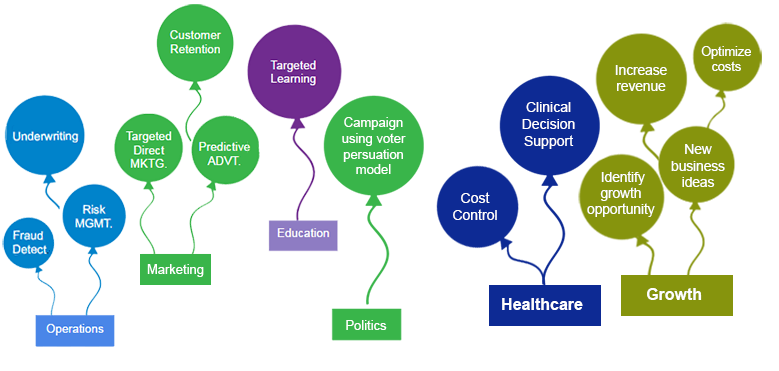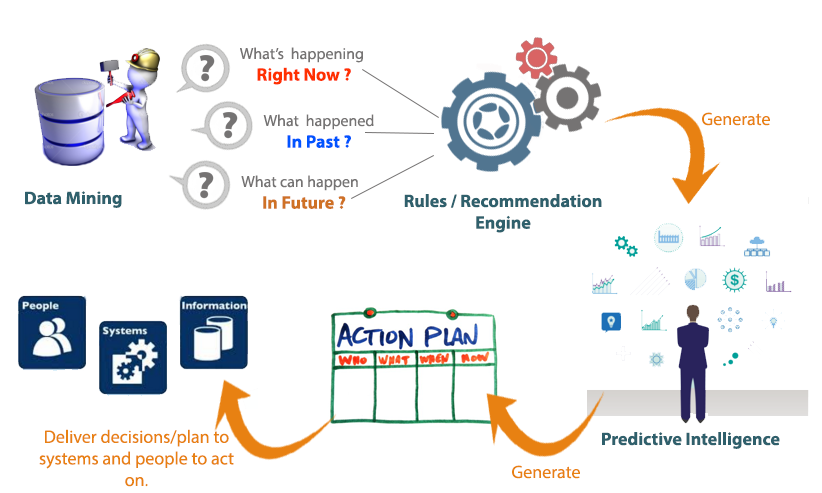Predictive Analytics in action - Real life industry examples
Predictive Analytics for Business Growth
Companies like Amazon and Uber are running and expanding their business using analytics.
Predictive Analytics applied to all the important pillars of growth like Sales, Lead Generation, User Experience, Performance, Retention etc., can yield fascinating information that can provide insights on what corrective or additional actions can be taken in order to hit the bull's eye and encash on the opportunities to the maximum.
Traditionally such kind of basic business intelligence and predictions have been done using manual techniques with paper and pen but the effectiveness was constrained with inefficiencies and human insightfulness.
Nowadays tremendous amount of data and cheap CPU power combined with intelligent predictive algorithms enables us to easily automate interestingly advanced predictions. Predictive Analytics can process Terabytes of structured and unstructured data to identify useful trends and complicated patterns within a matter of minutes that is beyond a normal human capacity. Such findings can be ultimately used to make appropriate decision for business.
For more detailed information you may want to visit our article Growth Analytics.
Predictive Analytics in HealthCare
Health expenditures in the United States crossed $3.0 trillion in 2013. Almost 15% of U.S GDP is spent on healthcare. A huge potential exists to use Predictive Analytics to cut down on healthcare costs by removing inefficiencies and reducing redundancies and administrative costs..
- Insurance companies
-
- are deploying predictive analytics on past claims and patient history to find ways to lower the expenditure on claims and medications.
- Detect and handle insurance claims fraud using predictive analytics
- Determine insurance premium rates and optimize claims processes using predictive analytics
- Retain customers, improve profitability and optimize marketing campaigns using predictive analytics
- Hospitals can also use predictive analytics to predict the effectiveness of new procedures, medical tests and medications.
You may also like our article specifically written on Healthcare Analytics.
Predictive Analytics in Manufacturing
Manual analytic models have been used for ages in manufacturing. Even simple, guess-based forecast models are technically a form of predictive analytics in manufacturing. Many countries like US and China are heavily pushing on use of automated Predictive Analytics in Manufacturing as a process.
Predictive Analytics can benefit four critical manufacturing processes:-
Quality improvement is one of the most common use of predictive analytics. We can run predictive analytics on warranty claims data to identify causes for low quality and production failures, to improve customer satisfaction and service. Furthermore, typical predictive analytics software are automatically performing these processes. As a result, the overall quality of the predictive analytics model is enhanced, providing a more robust plan of action for the manufacturer.
Demand Forecasting is another area where Predictive Analytics can assist the manufacturers. Predictive Analytics uses a comprehensive view of the manufacturer's processes to identify trends or anomalies and events that seem to recur with a recent data capture and analysis.
Machine Utilization is yet another area where Predictive Analytics is enabling manufacturers to make better use of machines. Predictive Analytics automates the analysis of data from sensors within equipment and automates the actual operation of these machines. Thus using Predictive Analytics the manufacturer can determine when machines may need to be brought online or shut off to prevent an issue.
Preventive Maintenance in the Factory - Predictive analytics can be used to analyse the patterns in which the faults occur in machines overtime. Based on that, Predictive Analytics can actually automate a preventive maintenance chart for all the equipment in factory. Such predictive maintenance reduces machine downtime and operating losses.
Predictive Analytics in Banking and Finance
Stringent regulations, changes and uncertainties have burdened Banking and Finance sector. This sector need to reduce risk, cut costs, retain customers and reduce losses while complying changing laws and regulations.
Here, Predictive Analytics can be used to :-
- Detect and reduce fraud,
- Measure credit risk,
- Maximize cross-sell/up-sell opportunities,
- customers and optimize marketing campaigns.
- Automated decisioning of credit card or loan applications.
Rules combined with predictive analytics and text mining can be used to gain more profitable customers and decrease risks. With the right kinds of predictive models, financial margins and customers both benefit from Predictive Analytics.
Predictive Analytics also helps reduce risks by combining structured and unstructured data to better evaluate claims, customers and applicants, enabling us to approve more customers for higher credit limits, without increasing default rates.
Predictive Analytics in Social Media
Scientists at Rensselaer Polytechnic Institute have found that it only takes 10% of Social Media Users to influence 60% to 80% of the remaining users, about a belief. Companies have hard time identifying those real 10% advocates or effectively reach out to them. Real challenge is the disconnected and unstructured media data which has to be painfully analysed first to make any sense of trends, interests and future predictions of customer behaviour.
Predictive Analytics comes really handy here.
- Predictive analytics provides insights by uncovering patterns and associations in unstructured social media data.
- Predictive Analytics can thus help decode users' behavior, attitudes and preferences and can forecast how users are likely to behave in the future.
- Predictive analytics also helps identify social media users who are more likely to buy a given thing and will also advocate for their brand based on their past behaviour and expression of interest in such items.
- Marketers then use these insights provided by predictive analytics to improve the conversion rates by providing the right content at the right time to the right audience, via the social influencers best fit to influence them.
Predictive analytics can do Intelligent Associations
Predictive Analytics can highlight early indicators of interest and purchase behavior by scanning through the keywords used in social media posts, and the sites visited by users when they talk about products.
Predictive analytics can also do intelligent associations by highlighting other things they may be interested in, but not necessarily mentioned in their posts, by analysing what they are talking about e.g "Finally got my own house, we will soon no longer have to pay hefty rentals" ...means the user is very soon most likely to use logistics services, packers and movers services in addition to buying stuff for their own house.
Such insights gained through Predictive Analytics, can easily be converted to real business. That's the power of predictive analytics!!
Predictive Analytics in Governments and the Public Sector
Predictive Analytics enables the systems to be pro-active rather than reactive and that is why Government and Public sectors are showing huge interest in Predictive Analytics. Predictive Analytics can be used to improve services, detect and prevent fraud, improper payments, misuse of taxpayer funds, and detect criminal activities and patterns.
Hospital's can predict emergency admissions using Predictive Analytics which enables them to provision the beds in advance. Predictive Analytics here can save huge cost on reactive staffing and overtime shifts, as well as avoids haphazard patient shiftings to clear up beds for emergency cases. This leads to happy staff and happy patients in addition to cost savings.
Predictive Analytics done over historical data of emergency response operations can predict as to how many people are required on call taking side and how many on dispatch side, on a given day. This builds a highly efficient system where people are not sitting idle and also that system is not too overworked and understaffed at demanding times.
Predictive Analytics can also be used to study past criminal behavior patterns and then mapping their anticipated future occurrence, to yield real-time intelligence for police departments, allowing for more effective use of forces.
Memphis Police Department (MPD) were dealing with steep crime growth rates of 2.5% with no substantial reduction. Traditional policing approaches and inefficient methods of paper-based crime analytics were becoming less effective. They partnered with the Memphis' Department of Criminology and Criminal Justice, which was already using predictive analytics software from IBM. They used evidence-based approach of Predictive Analytics that zeroed in on particular areas based on crime trend data, patrolling data etc. Once focus areas and timings became predictable, the agency utilized all the resources it has available to saturate those areas to prevent crime and make arrests.
Predictive Analytics in Entertainment.
Predictive Analytics is being heavily used these days by Hollywood to forecast box office returns. Predictive Analytics can determine appropriate audience for a given media or entertainment context, score visitors, study trends, likes/dislikes to predict a marketing strategy for a fruitful outcome of a movie or other entertainment media.
To achieve this, Predictive Analytics algorithms are run to analyse various different data sources that can give insight into what are people interested in these days and what can heighten their curiosity. The data sources for doing Predictive Analytics can include search engine results, video views and comments, ratings on expert websites and social media content. Predictive Analytics can also be done on the basis of past success records of other movies of the same genre or those starring the same people. The primary goal is to be able to accurately forecast the possible box office returns for a particular movie using the relevant kinds of data.
Predictive analytics can well be used to study the social media buzz and help shape up to ensure favorable positioning of the movie, determine the best timeframe to launch it and prospective initial city locations for the initial few releases, to make the first impression correct.
Another useful use case would be to use Predictive Analytics to determine when to launch the DVD of the movie as too early will hit the box office returns, while too late may fail to encash on the wave generated.
Netflix is the best case study of using Predictive Analytics to determine user behavior and hitting the jackpot ! Netflix original show The House Of Cards' was commissioned solely on the basis of the big data results of the preferences of its customers.
Lady Gaga and her team browse through our listening preferences and sequences and optimize the playlist for the maximum impact at live events.
Predictive Analytics done using sentimental analysis of social media buzz or current affairs can help shape script of next blockbuster.
Predictive Analytics in Retail
The influencing factors for a retail business across all industry verticals are common: historic sales and consumer demand, trends, seasonal fluctuations, price elasticity of demand, lead times, and so on. Predictive analytics done taking into account all these factors, and their inter-relations, can yield magical recommendations to grow the business many folds in unusual ways.
Predictive analytics can help understand customer behaviour by using customer data such as purchase history, average order value, last time purchased etc. Predictive analytics thus can help predict near-term and long-term customers, likelihood of when the customer will make their next purchase and what the value of that purchase will be. Based on that, targeted campaigns can be done, inventory quantity and variety to keep in store can be predicted.
Predictive analytics can also measure how effective are the promotional events and campaigns, determine which offers are most lucrative for a customer segment, can do logistics optimization and finally how to win customer loyalty.
| 





